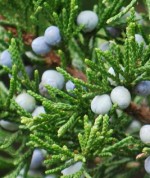 Eastern redcedar is an evergreen coniferous tree native to the woodland edges, old fields, meadows, and rocky ground of eastern North America from Nova Scotia and Ontario, south to Florida and Texas. It is a member of the cypress family, Cupressaceae, that also includes arborvites and junipers and is not a true cedar. The small to medium sized tree may be conical or oval to rounded and has reddish brown bark that is scented and exfoliates in thin ragged strips. The awl-like needles are olive to deep green, darkening or yellowing in winter. Male and female cones are produced on different trees. The female cones are blue-gray, berry-like and up to ¼ inch long while the male pollen cones are half that size. The seed cones are attractive to many birds. Eastern redcedar is a pioneer species and a tough plant that tolerates a wide variety of soil types, but not shade. It is a good choice for a hedge, windbreak, screen, and topiary but carries cedar apple rust so should not be planted near apple trees. The genus name Juniperus, is the Latin name for the plant. The specific epithet virginiana is the Latinized form of Virginia and refers to a type location.
Eastern redcedar is an evergreen coniferous tree native to the woodland edges, old fields, meadows, and rocky ground of eastern North America from Nova Scotia and Ontario, south to Florida and Texas. It is a member of the cypress family, Cupressaceae, that also includes arborvites and junipers and is not a true cedar. The small to medium sized tree may be conical or oval to rounded and has reddish brown bark that is scented and exfoliates in thin ragged strips. The awl-like needles are olive to deep green, darkening or yellowing in winter. Male and female cones are produced on different trees. The female cones are blue-gray, berry-like and up to ¼ inch long while the male pollen cones are half that size. The seed cones are attractive to many birds. Eastern redcedar is a pioneer species and a tough plant that tolerates a wide variety of soil types, but not shade. It is a good choice for a hedge, windbreak, screen, and topiary but carries cedar apple rust so should not be planted near apple trees. The genus name Juniperus, is the Latin name for the plant. The specific epithet virginiana is the Latinized form of Virginia and refers to a type location.
Type: Evergreen coniferous tree
Outstanding Feature: Tolerates wide variety of soil conditions
Form: Conical to oval or round
Growth Rate: Moderate
Bloom: Very small male and female berry-like cones on separate trees
Size: 25-60’ H x 10-20’ W
Light: Full sun
Soil: Average, dry to moist, well-drained but tolerates some wetness and drought
Hardiness: Zones 2-9
Care: Low maintenance; can be pruned if desired.
Pests and Diseases: Cedar-apple rust, twig blight, scale, bagworms, mites
Propagation: Seed